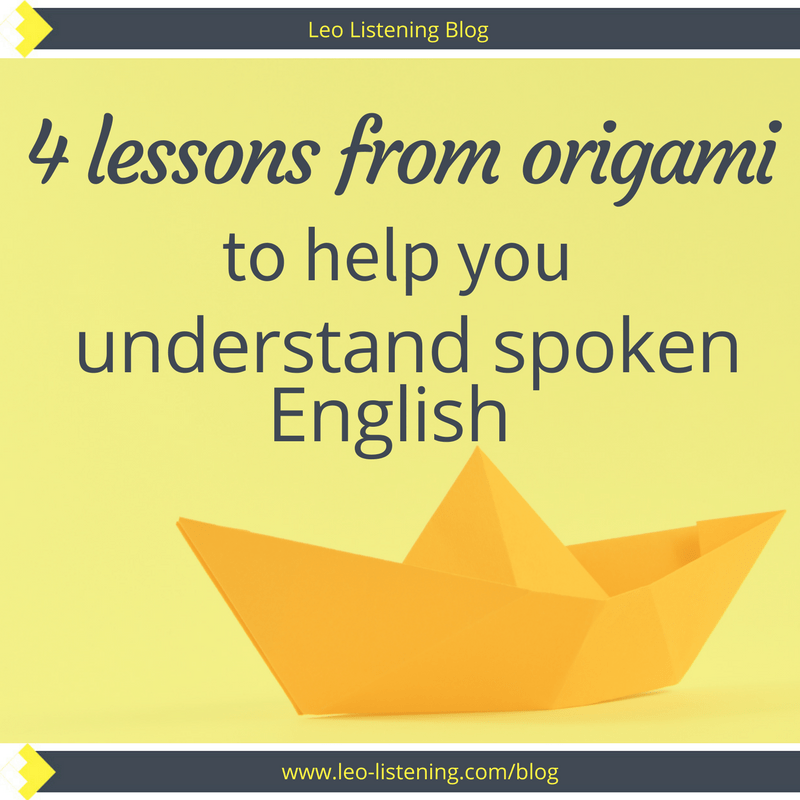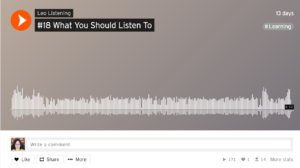4 Lessons From Origami To Help You Understand Spoken English

Have you ever done any origami?
It’s the Japanese art of folding paper. I got into it at school when I was about 9 or 10.
We had an origami book in the classroom. Our teacher would let us try making different things. I guess we had a pretty cool teacher. We should have been learning maths or something.
I’ve mostly abandoned my creative side as an adult. Like you, I get caught up in day to day demands: work, running a house, just trying to survive. Creativity doesn’t seem to have the same importance anymore.
It’s hard to believe because I was a really creative kid.
Last year, I decided to get back into origami. I bought myself a kit with instructions and sheets of beautiful paper.
For Christmas, I decided that I’d make some origami boxes for my closest friends.
As 20 years had gone by, I decided to practise a bit before I did the final versions with the pretty origami paper.
The advice in the book was:
- Practice and learn the basic folds
- Start off with easier designs before you try the harder ones
- Unfold and start again if it doesn’t work out
- Be as precise a possible

Trying to understand the instructions in the origami kit
Source: https://stocksnap.io/photo/9F7U4U4LBQ
I took some scrap paper and began learning on some of the basic folds. And then started following the instructions to make some easy designs including a sock, a shirt, a water bomb and a little box.
Of course, my first attempts didn’t work out too well. I wanted to be finished as soon as possible to get my cards and presents in the post in time for Christmas. But I had to take the time to re-learn my craft.
Even though I was practising by making different models, I had to add precision to my practice. In short, just practising by folding and following the steps wasn’t enough. I had to make sure I learned the basics, started simple, folded precisely and learned from my mistakes.
So how do these lessons connect to understanding spoken English?
Don’t just practice
A lot of students content themselves with “just practising” or “just listening”. We assume (as language learners or teachers) that listening is something that just comes on its own with enough practice.
You can learn the serious stuff like grammar or vocabulary. But you can’t learn how to listen.
I used to think like that too. One of the reasons I moved abroad was to get my French from B2/C1 up to C2 and beyond. I thought living abroad was the only way to do that. Nowadays, I know plenty of successful language learners who have advanced skills, without living abroad.
Their secret? They did the right kind of practice. Not just any kind, not just full immersion. And they used the right kinds of materials at the right time.
So how can you apply the lessons from origami so you’re not “just practising”?
1.Get back to basics
Before you attempt to make something cool like a swan or even a paper car, you need to learn the basic folds.
Has anyone ever explained to you how English really sounds when we speak? Have you ever done any pronunciation work? Do terms like the schwa sounds, linking and connected speech mean anything to you?
For many learners, this is the missing link. The key to unlocking comprehension in English.
If you only know how words look on a page, or how they sound in isolation, then you’ll struggle to catch them in fast, conversational English. You’ll even struggle to understand more careful or academic types of English.
One of the big problems in English is its stress pattern of weak syllables and weak forms. The grammatical words sound especially different. Add to this the connected speech magic tricks we perform and no wonder you can’t understand.
You’ll need a long time to understand all these words by just practising. In both my listening test and my group programme Dictate Your Listening Success, you hear real speech. And I explain why words you already know sound so different in fast, spoken English. So you can start catching them in real life.

Practice with scrap paper in the beginning
Source: https://pixabay.com/en/art-attachment-background-boat-89198/
2. Start small and simple
I wanted to make 6 boxes out of pretty paper in under half an hour. Even though I hadn’t made anything since I was a kid.
We’re all tempted to start with the end result in life right? And then get frustrated when we don’t achieve it. I mean, I get it:
- You want to watch a 2-hour film in English with no subtitles.
- You want to understand your fluent friends in a noisy bar.
- You want to listen to a fast radio presenter chatting away with no effort.
But you don’t start off by doing those things.
If I had started off trying to follow the 3 pages of instructions to make a car out of paper, I would have given up right away.
Instead, I started with simpler designs. Maybe not the coolest, or prettiest or most impressive. But, after practising the basic folds, I managed to make them. And if I keep going, I will be able to make those amazing designs later.
You can start small and simple too.
You can listen to audio you feel more comfortable with.
If you’re a bookworm, you can listen to audiobooks. The speech is slower than conversation and you can read at the same time if you have the book. You’ll see the correspondence between the written word and the spoken form.
You can access plenty of audiobooks for free. Over 900 on Open Culture for example.
You can listen to podcasts or watch videos for learners. The BBC or the British Council are great places to find high-quality, free material for learners of different levels.
You can watch film clips instead of whole films. You can even find cool, free tools to help you with that.
Start small and simple. Get confident. Keep going. Build up to the end result you want.
3. Be kind, rewind
When you learn a language at school, in a class of 30 students, the teacher is in control of most things.
What you listen to is no exception. I know from talking to some of you about your experiences that the teacher controls the resources. Or that you only listened to the teacher’s voice because there were no resources.
On the internet, you can find almost every possible listening resource imaginable. In most cases free of charge.
You’re in control of what you listen to and how you listen.
When I made a mistake in origami, I unfolded my paper and went back a few steps. I tried to understand what I had done wrong.
You can do this too. If you don’t understand something. Go back. Rewind. Ask yourself: what went wrong?

It’s easy to move back and forth within a Soundcloud track
On Soundcloud it’s really easy to move back and forth within a track. You can click on any point on the sound wave to listen from that section again.
4. Be precise and embrace your mistakes

You won’t start off by making beautiful cranes like this one. And you’ll have to be willing to make plenty of mistakes to get there.
Source: https://barnimages.com/origami-bird-hands/
As I tried to make my origami designs, I experienced failure. I followed the steps, but my designs didn’t turn out like the ones in the instruction book.
I started to do a better job when I focused on being more precise in my folds. Once I started folding precisely, not just randomly or how I’d normally fold a piece of paper, I saw a difference. The finished product looked much better.
The only way to get there was to admit my mistakes, go back a few steps and then start doing a better job.
If you want to understand spoken English, mistakes will need to become your friends.
The only way I can get into my learners’ heads is through their mistakes. I can predict what they might find difficult in a recording. But, ultimately, my learners teach me about what their struggles are by what they can’t do.
The best way for me to see this is to get them to write what they hear. So I get them to do dictations.
I used to think this was some form of torture. Because I used to think the only way to work on listening was to answer a few multiple choice of true or false questions. Now I know that this leads to guessing, not to learning.
When you write what you hear and compare it to the original, you get closer to understanding.
If you have a teacher or a guide to explain why you can’t understand, then you’re on the path to learning.
When you start paying more attention to the words and expressions you find hard to catch, you start to notice them better.
Knowing what you’re looking for and noticing it leads to learning.